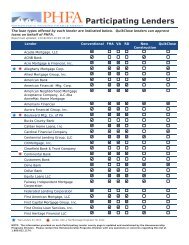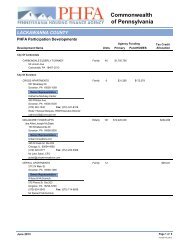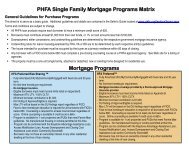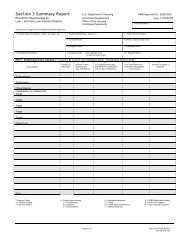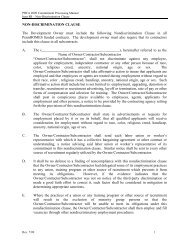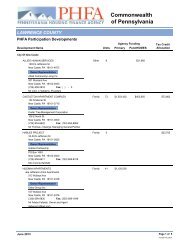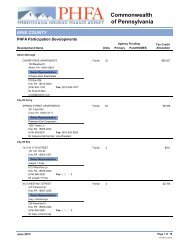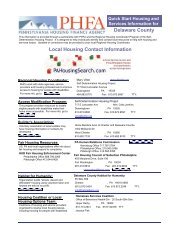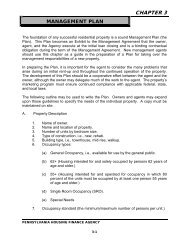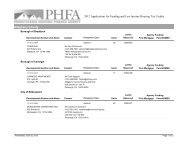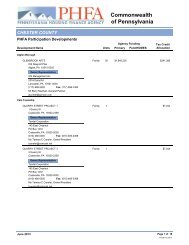2012 PHFA Annual Report - Pennsylvania Housing Finance Agency
2012 PHFA Annual Report - Pennsylvania Housing Finance Agency
2012 PHFA Annual Report - Pennsylvania Housing Finance Agency
You also want an ePaper? Increase the reach of your titles
YUMPU automatically turns print PDFs into web optimized ePapers that Google loves.
<strong>Pennsylvania</strong> <strong>Housing</strong> <strong>Finance</strong> <strong>Agency</strong><br />
Notes to Financial Statements<br />
(in thousands of dollars) June 30, <strong>2012</strong> and 2011<br />
premiums, less repayments and allowance for loan losses, if any.<br />
The current portion of mortgage loans receivable represents<br />
the contractual amount due within the next year. The allowance<br />
for loan losses is determined based upon management’s<br />
evaluation of mortgage loans receivable and construction<br />
advances. Factors considered by management include the<br />
estimated fair values of the properties that represent collateral,<br />
mortgage insurance coverage on the collateral, the financial<br />
condition of the borrower and the economy as a whole. While<br />
management uses available information to recognize losses<br />
on mortgage loans, future additions to the allowance may be<br />
necessary based on changes in economic conditions.<br />
Real Estate OwnED<br />
During the normal course of business, the <strong>Agency</strong> acquires and<br />
holds for sale single-family real estate because of foreclosure,<br />
acceptance of a deed in lieu of foreclosure or other defaults<br />
of nonperforming mortgage loans. The outstanding mortgage<br />
balances attributable to these properties, stated at cost, are<br />
included as mortgage loans receivable on the Balance Sheets<br />
of the Single Family Mortgage Loan Program. In addition to<br />
the potential recovery from the sale of real estate owned, are<br />
recoveries from the u.S. Department of <strong>Housing</strong> and Urban<br />
Development, other federal government programs or private<br />
mortgage insurance.<br />
Capital Assets<br />
The <strong>Agency</strong> capitalizes capital assets with an initial cost of<br />
$1 or more. Depreciation is calculated using the straight-line<br />
method over the estimated useful lives, which ranges from<br />
5 to 45 years. When capital assets are disposed, the cost<br />
and related accumulated depreciation are removed from<br />
the accounts and any resulting gain or loss is recorded as a<br />
revenue or expense.<br />
Due To and Due from OtHEr<br />
Funds and Interfund Transfers<br />
To meet liquidity requirements of individual funds, the <strong>Agency</strong><br />
transfers funds to and from the separate enterprise funds.<br />
The <strong>Agency</strong> makes interfund transfers to the extent that<br />
such transfers are not required to meet the <strong>Agency</strong>’s debt<br />
obligations and if such transfers are not in violation of the<br />
terms of bond resolutions or indentures. Transactions which<br />
have not been settled at the year-end are recorded as due to<br />
or due from other funds.<br />
Other Assets and Other LiABilities<br />
Accounts that do not fit into the classifications on the Balance<br />
Sheets are reported as other assets and other liabilities. Other<br />
assets consist mainly of net pension assets, federal funding<br />
receivables, prepaid expenses and the deferred costs of bond<br />
issuance. Other liabilities consist of escrow deposits, deferred<br />
revenues, OPEB obligations, deferred federal funding and<br />
accrued expenses.<br />
Bonds and Notes PayABLE, Net of<br />
Discounts and Loss on Refunding<br />
The <strong>Agency</strong> issues bonds to provide capital for its mortgage<br />
programs and other uses consistent with its mission.<br />
The bonds are secured by the revenues, investments, mortgage<br />
loans and other assets in the fund or accounts established by<br />
the respective security agreements. Outstanding bonds are<br />
stated at their unpaid balance less any unamortized discounts<br />
and unamortized deferred loss of refunding. The current<br />
portion of bonds and notes payable represents the principal<br />
payable within the next year.<br />
Interest Rate SwAP AgrEEMEnts<br />
The <strong>Agency</strong> enters into interest rate swap agreements with<br />
various counterparties to hedge the interest rate exposure<br />
associated with variable-rate debt and reduce overall<br />
borrowing costs. The interest rate swap agreements are<br />
structured whereby the <strong>Agency</strong> pays the counterparty a fixed<br />
interest rate in exchange for a variable interest rate payment<br />
from the counter-party. In accordance with GASB Statement<br />
No. 53, Accounting and Financial <strong>Report</strong>ing for Derivative<br />
Instruments, interest rate swap agreements are stated at<br />
fair value on the Balance Sheets. The fair value of hedging<br />
derivative instruments is presented on the Balance Sheets as<br />
Derivative Instrument – Interest Rate Swaps, and changes in<br />
fair values are presented on the Balance Sheets as Deferred<br />
Outflow of Resources. The fair values of investment derivative<br />
instruments are presented as Derivative Instrument – Interest<br />
Rate Swaps on the Balance Sheets; however, the changes in<br />
fair values are no longer deferred, but recognized as a revenue<br />
or expense. In the instance of termination events, fair value of<br />
the interest rate swaps at the time of termination are reclassified<br />
on the Balance Sheet from Derivative Instrument – Interest Rate<br />
Swaps to Deferred Swap Borrowing and the values at the time of<br />
termination recorded as a Special Item expense. In accordance<br />
with GASB Statement No. 53, the Deferred Swap Borrowing<br />
account will be amortized and recognized as revenue over the<br />
lives of the underlying interest rate swaps in order to recoup the<br />
effects of the Special Item expense over time.<br />
DevELoPMEnt Reserves<br />
and Escrow Deposits<br />
The <strong>Agency</strong> holds, in escrow, monthly deposits from the<br />
single-family homeowners and multifamily developments<br />
for payments of real estate taxes, property insurance and<br />
mortgage insurance. Development reserves represent<br />
operating reserves for repairs and replacement, property<br />
improvements and operating deficit reserves.<br />
Net Assets<br />
Net assets are classified in the following three components:<br />
Invested in Capital Assets, Net of Related Debt —<br />
This component consists of capital assets, net of<br />
accumulated depreciation, reduced by the outstanding<br />
balances of any debt that is attributable to the acquisition,<br />
construction or improvement of those assets.<br />
Restricted — Consists of net assets with constraints<br />
placed on their use by (1) <strong>Agency</strong> bond resolutions or<br />
external groups, such as creditors, grantors, laws or<br />
regulations of other governments or (2) law through<br />
enabling legislation in accordance with GASB Statement<br />
No. 46, Net Assets Restricted by Enabling Legislation, an<br />
amendment of GASB Statement No. 34.<br />
Unrestricted — Consists of net assets that do not<br />
meet the definition of invested in capital assets, net<br />
of related debt or restricted. This component includes<br />
net assets designated for specific purposes by the<br />
Members of the Board.<br />
When both restricted and unrestricted resources are available<br />
in a fund, it is the <strong>Agency</strong>’s policy to spend restricted resources<br />
to the extent allowed and only spend unrestricted resources<br />
when needed.<br />
Operating Revenues and ExPEnses<br />
The initial legislation and subsequent amendments that<br />
created the <strong>Agency</strong> grant the authority to issue debt to<br />
finance its Multifamily <strong>Housing</strong> and Single Family Mortgage<br />
Loan programs. Additionally, the <strong>Agency</strong>’s statutory purpose<br />
includes the authority to act as a conduit for federal financial<br />
assistance programs throughout the Commonwealth.<br />
The <strong>Agency</strong> records all revenue from mortgage and loan<br />
activity, mortgage servicing, grant program administration,<br />
investment income and gains on the sale of pooled<br />
loans to Government National Mortgage Association as<br />
40<br />
<strong>2012</strong> Financial statements annual report <strong>2012</strong><br />
41



